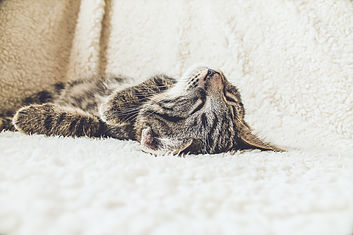Scratching is a normal behavior of cats. Scratching allows cats to exercise, mark territory, condition the claws, stretch, and defend themselves. Many cats can be trained to scratch only on appropriate surfaces. In some cases, cats may excessively scratch or scratch on undesirable surfaces to us such as the couch, curtains or owners. If a cat is destructive or is injuring people or other pets with its claws, declawing is an acceptable alternative.
What are the alternatives to declawing?
Providing appropriate scratching surfaces.
Most cats prefer to scratch vertically, but some enjoy horizontal scratching posts. Experiment with different styles, shapes and textures of posts to find what your cat likes best. (carpet, rope, cardboard and bark posts are available options)
- Posts should be taller than their body length to fully stretch and scratch
- Location is important
- Cats often stretch upon waking, put one post near where they sleep
- Cats will also scratch in social areas such as the living room or dining room
- If you cat is scratching somewhere you do not like, try putting a post near that location – when he/she tries to scratch the wrong spot, gently pick them up and place them near the desired scratching location and reward them for making the right choice.
To encourage scratching post use, try using catnip or Feliscratch spray on the desired scratching locations, and praise your cat for using the post. For more information on Feliscratch spray visit: https://www.feliway.com/us/FELISCRATCH-by-FELIWAY2
Trim nails frequently – this can be done at home, or by one of our certified veterinary technicians at Lodi Veterinary Care
Nail caps – plastic nail caps can be applied to the nails to reduce damage caused by scratching. These can be purchased and applied by yourself at home, or by one of our certified veterinary technicians at Lodi Veterinary Care. Nail caps will need to be replaced approximately every 4-6 weeks. For more information on nail caps visit www.softpaws.com
Avoid using hands or other body parts as a toy when playing with cats and kittens. This form of play can encourage biting or scratching and as cats grow, they will acknowledge this as an appropriate form of play. Instead, play with interactive toys like wands, feathers and toy mice and other toys that mimic hunting and chasing prey. This will encourage using toys instead of scratching or batting at people when trying to elicit play.
Please do not hesitate discussing declawing and its alternatives with any of the veterinarians at Lodi Veterinary Care. Together we can make a thoughtful and appropriate decision on what is best for your cat.
Sources:
- American Veterinary Medical Association www.avma.org/declaw
- American Association of Feline Practicioners www.catvets.com
- Ohio State University College of Veterinary Medicine Indoor Pet Initiative www.indoorpet.osu.edu/cats

